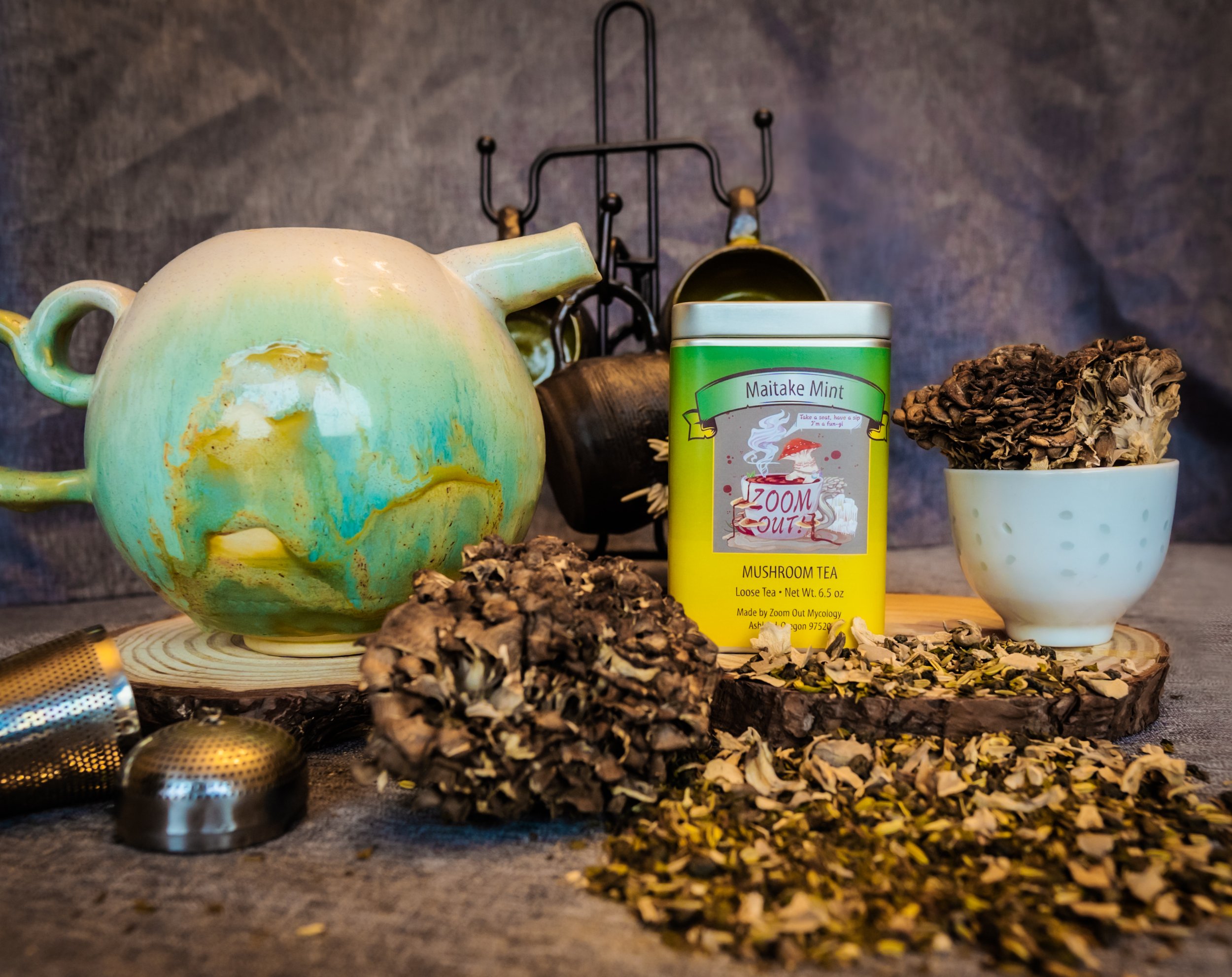The Top Health Benefits of ZOM Mushroom Tea: Maitake Mint
Maitake Mint is an earthy and minty mushroom tea blend. The main ingredient is maitake mushroom (Grifola frondosa), and it is complemented by peppermint, green tea, and fennel. Maitake, which translates to “dancing mushroom” in Japanese, was so named because when people would find the mushroom they would dance with joy. It is a medicinal mushroom that has been studied for its properties in treating and managing disease. Read on to learn how drinking Maitake Mint after a meal can add benefits to your health. This article will focus on the benefits of the ingredients in the mushroom tea that have the most scientific evidence and study behind them.
A 2009 study on breast cancer patients found that when patients took liquid maitake extract, they had improved immunological responses, meaning that immune cells like T cells and B lymphocytes had improved cytokine production. Cytokines are small proteins that signal for immune and inflammation responses in the body. Additionally, maitake has been researched for its effects on treating diabetes; maitake naturally lowers blood sugar because it contains alpha-glucosidase inhibitors. Studies on diabetic mice have shown maitake to have an effect on insulin receptors by both increasing insulin sensitivity and decreasing insulin resistance.
Peppermint has been thoroughly studied for its digestive benefits. The main components, menthone and menthol, work to relax the muscles in the digestive system, which leads to relief of gas, constipation, and bloating. It is also an effective treatment for irritable bowel syndrome, with a 2016 study showing a reduction in IBS symptoms by 40% over only one month.
Green tea is another ingredient that has both heaps of anecdotal and scientific evidence to back it up. It contains several compounds that have been linked to a reduced risk of cancer, with several studies demonstrating that drinking green tea was directly linked to a lower risk of breast cancer, prostate cancer, and colorectal cancer.
Fennel is a nutritious herb that contains high levels of vitamin C, which is essential for a healthy and balanced diet. Vitamin C is especially recognized for its role in maintaining a healthy immune system, reducing the severity of allergic reactions, and helping to fight off infection. It is also an antioxidant, and used as a therapeutic treatment for several diseases and disorders. Fennel also contains antispasmodic agents, which can help ease menstrual cramps. In a 2013 study, researchers found that taking fennel provided women with relief from painful menstrual cramps.
It’s important to note that when brewing medicinal mushroom tea, the process is different than the average tea-drinker may be used to. To get the most out of our tea blends, be sure to steep your tea for a full 60 minutes. This period of time allows for the mushrooms to break down and increase the bioavailability of compounds for ingestion.
Finally, Bashira Muhammad, founder of Zoom Out Mycology and creator of Maitake Mint, shares a few words on the mushroom tea blend: Maitake mint is a refreshing, yet earthy blend of tea. The mushroom brings a nutty flavor, and I have had the honor of hearing many stories of cancer survivors who benefitted from utilizing Maitake mushroom in their treatments. The timing and reasoning behind when I choose to brew up some Maitake Mint is definitely for menstrual cramp relief in the first few days of my period. I like to drink Maitake cold on the type of period days that I have to simply power through, like event and trade-show days. However, I always enjoy Maitake brewed hot during the days of my period that I’m relaxing.
Medicinal properties found within the Maitake Mint tea blend according to each ingredient.
Sources
Deng et al, 2009. “A phase I/II trial of a polysaccharide extract from Grifola frondosa (Maitake mushroom) in breast cancer patients: immunological effects.” Journal of Cancer Research and Clinical Oncology. https://doi.org/10.1007/s00432-009-0562-z
De Silva et al, 2012. “Medicinal mushrooms in prevention and control of diabetes mellitus.” Fungal Diversity. https://doi.org/10.1007/s13225-012-0187-4
McKay & Blumberg, 2006. “A review of the bioactivity and potential health benefits of peppermint tea (Mentha piperita L.).” Phytotherapy Research. DOI: 10.1002/ptr.1936
Cash et al, 2016. “A Novel Delivery System of Peppermint Oil Is an Effective Therapy for Irritable Bowel Syndrome Symptoms.” Digestive Diseases and Sciences. DOI: 10.1007/s10620-015-3858-7
Ogunleye et al, 2010. “Green tea consumption and breast cancer risk or recurrence: a meta-analysis.” Breast Cancer Research and Treatment. DOI: 10.1007/s10549-009-0415-0
Kurahashi et al, 2008. “Green Tea Consumption and Prostate Cancer Risk in Japanese Men: A Prospective Study.” American Journal of Epidemiology. https://doi.org/10.1093/aje/kwm249
Chen et al, 2017. “An inverse association between tea consumption and colorectal cancer risk.” Oncotarget. DOI: 10.18632/oncotarget.16959
Chambial et al, 2013. “Vitamin C in Disease Prevention and Cure: An Overview.” Indian Journal of Clinical Biochemistry. DOI: 10.1007/s12291-013-0375-3
Bokaie et al, 2013. “Oral fennel (Foeniculum vulgare) drop effect on primary dysmenorrhea: Effectiveness of herbal drug.” Iranian Journal of Nursing and Midwifery Research. https://www.ncbi.nlm.nih.gov/pmc/articles/PMC3748568/


